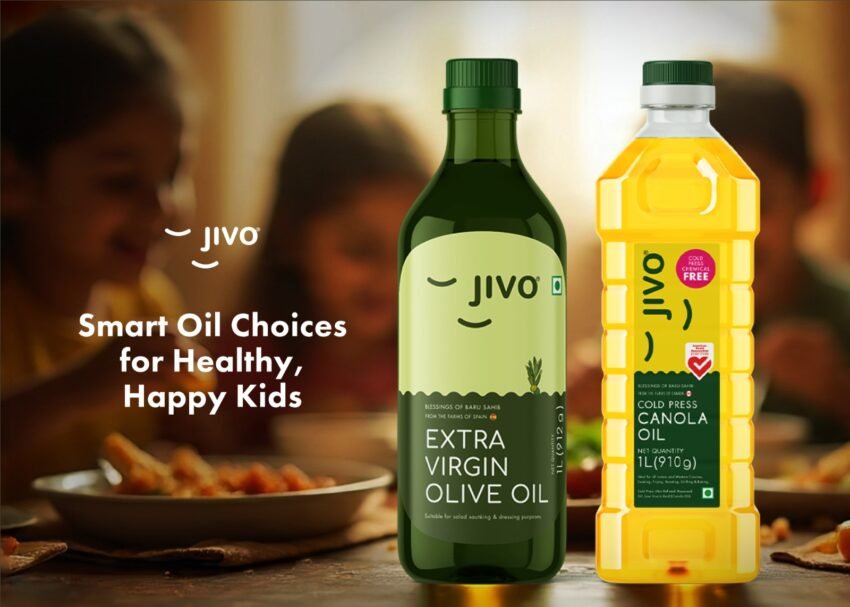As parents, ensuring our children get the right nutrition is a top priority. Cooking oils play a crucial role in daily meals, providing essential fats that support growth, brain development, and overall health. But with so many options available, from refined varieties to healthy cold-pressed oils, it’s easy to wonder: how much is too much, and what’s truly healthy for kids? In this comprehensive guide, we’ll explore the recommended amounts of cooking oil consumption for children, the nutritional benefits, and tips for choosing the best cooking oils in India. We’ll also discuss fssai-compliant cooking oils and nutritional cooking oils that can make a positive difference in your child’s diet. By the end, you’ll have a clear understanding to make informed choices for your family’s kitchen.
Why Cooking Oils Matter for Children’s Health
Cooking oils are more than just a medium for frying or sautéing; they’re a source of vital nutrients. Fats from oils help absorb vitamins like A, D, E, and K, which are essential for bone health, immunity, and vision. For growing kids, these fats provide energy for play and learning while supporting cell membrane formation and hormone production.
However, not all oils are created equal. Refined oils undergo high-heat processing and chemical extraction, which can strip away natural antioxidants and introduce trans fats. On the other hand, healthy cold-pressed oils are extracted at low temperatures without chemicals, preserving nutrients like vitamin E and omega-3 fatty acids. These make them a superior choice for children’s meals, as they offer anti-inflammatory benefits and support heart health from a young age. Studies show that incorporating nutritional cooking oils rich in unsaturated fats can even boost cognitive development in kids.
In India, where traditional diets often include oils like mustard or coconut, selecting fssai-compliant cooking oils ensures safety and quality. The Food Safety and Standards Authority of India (FSSAI) sets strict guidelines, such as limiting trans fats to no more than 2% by weight in edible oils, to prevent health risks like obesity and heart disease. This is particularly important for kids, whose bodies are still developing and more sensitive to poor-quality ingredients.
Types of Cooking Oils: Refined vs. Healthy Cold-Pressed Options
To choose the best cooking oils in India for your family, it’s helpful to understand the main categories. Refined oils, like many sunflower or soybean varieties, are processed to have a higher smoke point and longer shelf life, but they lose much of their natural goodness. Healthy cold-pressed oils, extracted mechanically without heat or solvents, retain flavors, aromas, and health-boosting compounds.
Popular nutritional cooking oils include:
Olive Oil: Extra virgin olive oil is packed with monounsaturated fats that promote heart health and reduce inflammation. It’s ideal for light sautéing or dressings, making it one of the best cooking oils in India for kids’ salads or pasta.
Coconut Oil: Common in southern Indian cuisine, it contains medium-chain triglycerides (MCTs) that provide quick energy and support brain function. Virgin coconut oil is a healthy cold-pressed option for curries or baking.
Mustard Oil: A staple in northern India, it’s rich in omega-3s and has antimicrobial properties. Fssai-compliant cooking oils like cold-pressed mustard oil are great for stir-fries, offering a pungent flavor that enhances traditional dishes.
Groundnut (Peanut) Oil: High in vitamin E and monounsaturated fats, it’s suitable for deep-frying due to its high smoke point. Cold-pressed groundnut oil versions are among the nutritional cooking oils that support skin health in children.
Canola Oil: Low in saturated fats and high in omega-3s, it’s a versatile choice for everyday cooking. Healthy cold-pressed canola oils are gaining popularity in India for their neutral taste and heart-protective benefits.
Sesame Oil: Rich in antioxidants, it’s used in Asian-inspired meals and provides lignans that aid digestion. It’s one of the best cooking oils in India for tempering dals or veggies.
When selecting fssai-compliant cooking oils, look for labels indicating compliance with standards like acidity levels below 0.5% and peroxide values under 10 meq/kg, ensuring purity and safety. For kids, prioritize healthy cold-pressed oils to maximize nutritional benefits without additives.
Nutritional Benefits of Oils for Growing Children
Fats aren’t the enemy—they’re essential for kids’ development. Nutritional cooking oils supply essential fatty acids (EFAs) like omega-3 and omega-6, which the body can’t produce on its own. These support brain growth, with omega-3s linked to better concentration and reduced ADHD symptoms in children. Healthy cold-pressed oils also contain antioxidants that fight free radicals, boosting immunity and protecting against infections common in school-going kids.
For instance, monounsaturated fats in olive or canola oil help maintain healthy cholesterol levels, reducing the risk of future heart issues. Polyunsaturated fats from sesame or sunflower oils aid in cell repair and hormone balance. Even saturated fats, like those in coconut oil, have benefits in moderation, providing antimicrobial lauric acid that supports gut health.
In India, where diets may lack diverse fats, incorporating the best cooking oils in India ensures kids get a balanced intake. Fssai-compliant cooking oils prevent exposure to harmful contaminants, while nutritional cooking oils like cold-pressed varieties enhance flavor without compromising health.
Recommended Daily Cooking Oil Consumption for Kids
Now, to the core question: how much cooking oil is healthy for kids? It’s not about oil alone but total fat intake, as oils contribute significantly to daily fats. Guidelines from health organizations like the American Heart Association and WHO provide age-specific recommendations.
For children aged 1-3 years, fats should comprise 30-40% of total calories. With a daily calorie need of 1,000-1,400 kcal, this translates to 33-62 grams of fat per day. Since 1 tablespoon (about 14g) of oil provides around 14g of fat, aim for 2-4 tablespoons total fats from all sources, including oils, dairy, and nuts. Practically, this means using 1-2 teaspoons of oil per meal for cooking.
For kids 4-8 years, fats drop to 25-35% of calories, with daily needs at 1,200-1,800 kcal, equating to 33-70g fat. This allows for about 2-3 tablespoons of oil daily, spread across meals. Older children (9-13 years) need 1,600-2,200 kcal, with 25-35% from fats (44-86g), supporting up to 3-4 tablespoons.
These are general; actual needs vary. For example, active kids may require more, while those with conditions like obesity should limit to the lower end. Remember, cooking oil isn’t the only fat source—avocados, eggs, and fish contribute too. To calculate: If a child’s diet includes dairy (providing 10-20g fat), aim for 20-40g from oils, or about 1.5-3 tablespoons daily.
In Indian households, where rotis or rice are staples, using healthy cold-pressed oils in moderation prevents excess calorie intake. Fssai-compliant cooking oils ensure no hidden trans fats sneak in, keeping intake safe.
Factors Affecting Oil Consumption in Children
Several factors influence how much oil kids should consume:
Age and Growth Stage: Toddlers need higher fat percentages for brain myelination, while teens focus on balanced fats for hormonal health.
Activity Level: Sporty kids burn more calories, allowing slightly more nutritional cooking oils without weight gain.
Dietary Patterns: Vegetarian diets may rely more on oils for EFAs, so choose the best cooking oils in India like canola or flaxseed blends.
Health Conditions: Kids with allergies avoid nut-based oils; those with high cholesterol benefit from low-saturated options like healthy cold-pressed oils.
Cultural Preferences: In India, regional tastes favor mustard in the north or coconut in the south, but always opt for fssai-compliant cooking oils.
Monitoring portion sizes is key—use measuring spoons to avoid overpouring. Baking or steaming reduces oil needs, promoting healthier habits.
Tips for Incorporating Healthy Oils into Kids’ Meals
Make oils work for you by:
- Drizzling olive oil on veggies for vitamin absorption.
- Using coconut oil in smoothies for a tropical twist.
- Opting for cold-pressed mustard oil in pickles for flavor and probiotics.
Encourage variety to expose kids to different nutrients, always checking for fssai-compliant labels.
Choosing Jivo’s Cold-Pressed Oil for Children
When it comes to selecting the ideal oil for kids, Jivo’s cold-pressed range stands out for its quality and health focus. Among their products, Jivo Cold Pressed Canola Oil is particularly suitable for children. It’s lowest in saturated fats and highest in unsaturated fats like omega-3 and omega-6, which are crucial for brain development and heart health. This fssai-compliant cooking oil has a neutral taste, making it versatile for Indian dishes like stir-fries or baking, without overpowering flavors kids might dislike. Reviews highlight its light texture and low absorption, reducing overall oil intake by up to 20% in fried foods—perfect for growing kids. Jivo’s cold-pressing method preserves natural nutrients, aligning with the benefits of healthy cold-pressed oils for immunity and growth. For parents seeking nutritional cooking oils, this is one of the best cooking oils in India to introduce early for lifelong healthy habits.
Conclusion
Balancing cooking oil consumption is about quality over quantity. By sticking to recommended intakes—around 30-40% fats for toddlers and 25-35% for older kids—and choosing healthy cold-pressed oils, you can support your child’s optimal health. Incorporate variety from the best cooking oils in India, ensure they’re fssai-compliant, and monitor for individual needs. With mindful choices, oils become allies in nurturing happy, healthy kids.
Disclaimer: This blog is for informational purposes only and not a substitute for professional medical advice. Consult a pediatrician or nutritionist before making dietary changes, especially for children with health conditions. Individual needs vary, and excessive fat intake can lead to issues like obesity. Always verify product labels for the latest fssai compliance.

